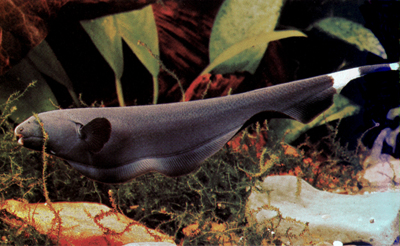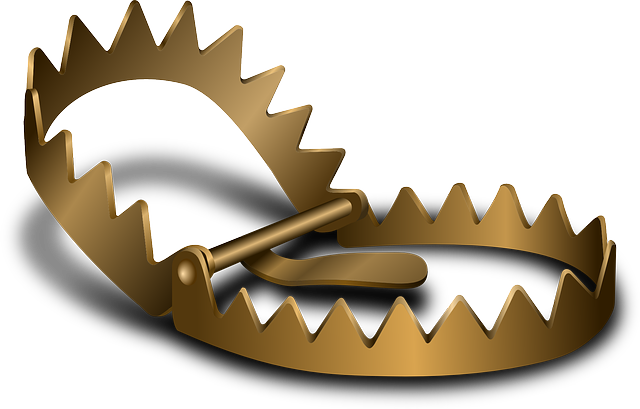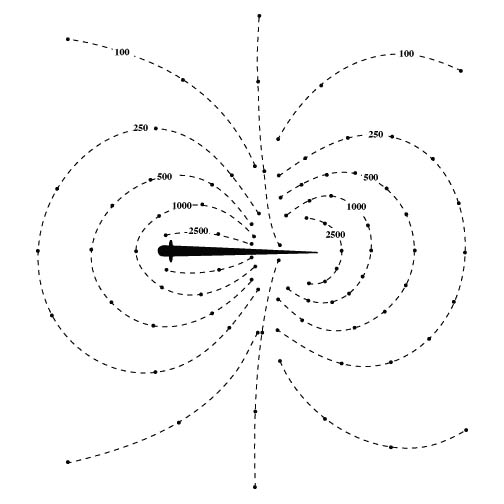Learn more about the Nelson Lab.
 The Nelson Lab's research is focused on active sensory acquisition. We seek to understand neural mechanisms and computational principles that animals use to actively acquire sensory information in complex, dynamic environments. We are interested in systems-level integration and interactions of:
The Nelson Lab's research is focused on active sensory acquisition. We seek to understand neural mechanisms and computational principles that animals use to actively acquire sensory information in complex, dynamic environments. We are interested in systems-level integration and interactions of:
- neural coding and spike train statistics
- sensory signal detection and estimation
- active repositioning of sensor arrays
- multiresolution adaptive filtering
- processing of clustered sensory signals
- generation and subtraction of sensory expectation
We study these processes in the electrosensory system of weakly electric fish, using a combination of behavioral, electrophysiological, and computational neuroscience approaches.
Our Principal Investigator is Mark E. Nelson.
Click the tabs below learn more about our research or check out our website here to learn more.
Studies of neural information processing in general, and sensory acquisition in particular, are best carried out under conditions that closely approximate the animal's natural environment. Each species has evolved solutions that are adapted to its own behavioral needs and ecological niche. Within this context, we can ask meaningful questions about how the nervous system acquires and processes sensory information. The neural mechanisms and information processing principles that emerge from a careful neuroethological study can have implications beyond the particular system in which they are elucidated. While focusing on the neural and behavioral strategies used by weakly electric fish to detect and capture prey, our goal is to contribute toward a broader understanding of general principles of sensory acquisition. Specific areas of interest include optimal positioning of receptor structures, efficient neural coding, task-specific adaptive filtering, and the generation and subtraction of sensory expectation. Many of the details will, of course, be specific to the electrosensory system, but the general principles that emerge should be broadly applicable to many other systems. Ultimately, we hope to come away with a deeper appreciation of how animals achieve their remarkable information processing capabilities.
Neural and Behavioral Strategies for Active Acquisition of Sensory Information
 To help guide behavior in complex, dynamically changing environments, animals must extract useful information from a barrage of physical stimuli impinging on their body surface. To meet this challenge, animals have evolved sophisticated sensory systems for encoding and optimizing the behaviorally relevant content of incoming signals. The focus of our research is on how the nervous system controls the acquisition of sensory information from the environment. How do animals cope with the real-time processing of sensory data from large numbers of input channels? How is the information encoded? How does the nervous system extract interesting information from the data stream while ignoring irrelevant background noise?
To help guide behavior in complex, dynamically changing environments, animals must extract useful information from a barrage of physical stimuli impinging on their body surface. To meet this challenge, animals have evolved sophisticated sensory systems for encoding and optimizing the behaviorally relevant content of incoming signals. The focus of our research is on how the nervous system controls the acquisition of sensory information from the environment. How do animals cope with the real-time processing of sensory data from large numbers of input channels? How is the information encoded? How does the nervous system extract interesting information from the data stream while ignoring irrelevant background noise?
One interesting aspect of this problem is that the nervous system can actively influence both the content and quality of the incoming data. For example, animals have the ability to reposition their sensor arrays, adjust receptor sensitivity, modify neural filtering properties to enhance signals of interest and suppress backgrounds. We study these processes in the electrosensory system of weakly electric fish. These fish use self-generated, millivolt-level electric fields to hunt, navigate and communicate at night in the tropical rivers of South America and Africa. Ongoing projects in the lab include analyzing naturalistic electrosensory signals and backgrounds in free-swimming fish, recording neural activity in electrosensory areas of the brain, and developing computational models of electrosensory information processing. The long-term goal of this research is to understand the general neural mechanisms and computational principles involved in active sensory acquisition.
Behavioral Aspects of Electrosensory Acquisition
 Weakly electric fish can influence the information they acquire through repositioning of their peripheral electroreceptor array, which covers the body surface. We have explored the role of body positioning in electrosensory acquisition by carefully analyzing the prey capture behavior of the black ghost knife fish, Apteronotus albifrons (Nelson and MacIver 1999 [pdf]; MacIver et al. 2001 [pdf]). We developed a multi-camera infrared video system and a novel 3D, model-based motion tracking system (MacIver & Nelson 2000 [pdf]) to extract information on fish body position and conformation as the fish hunts for small water fleas (Daphnia magna) in the dark. We established that the fish are able to detect prey in the absence of visual cues at distances of 1.5-2.5 cm from the body surface. Furthermore, we demonstrated that the mean detection distance depended on the electrical conductivity of the water (MacIver et al. 2001 [pdf]). This implies that detection in Apteronotus is primarily mediated by electrical cues, rather than other modalities, such as mechanical vibrations or chemical signals.
Weakly electric fish can influence the information they acquire through repositioning of their peripheral electroreceptor array, which covers the body surface. We have explored the role of body positioning in electrosensory acquisition by carefully analyzing the prey capture behavior of the black ghost knife fish, Apteronotus albifrons (Nelson and MacIver 1999 [pdf]; MacIver et al. 2001 [pdf]). We developed a multi-camera infrared video system and a novel 3D, model-based motion tracking system (MacIver & Nelson 2000 [pdf]) to extract information on fish body position and conformation as the fish hunts for small water fleas (Daphnia magna) in the dark. We established that the fish are able to detect prey in the absence of visual cues at distances of 1.5-2.5 cm from the body surface. Furthermore, we demonstrated that the mean detection distance depended on the electrical conductivity of the water (MacIver et al. 2001 [pdf]). This implies that detection in Apteronotus is primarily mediated by electrical cues, rather than other modalities, such as mechanical vibrations or chemical signals.
Our results provide the most direct evidence to date for the involvement of electrosensory cues in the of these fish. Computer modeling was used to reconstruct the electrosensory images experienced by the fish during prey capture sequences. This approach allowed us to gain insight into the sensory consequences of changes in body posture and orientation. For example, a typical post-detection strategy used by the fish is to roll its body to bring the prey directly above the dorsal midline, while simultaneously reversing swimming direction to back up and capture the prey. These strategies:
- Maintain the target within a spatially restricted sensory envelope.
- Facilitate azimuthal localization through left-right body comparisons.
- Move the electrosensory image into regions of progressively higher receptor density (dorsal and head regions), thus increasing the signal-to-noise ratio (SNR).
Coding by Primary Electrosensory Afferents
Voltage patterns on the skin must be converted into a neural representation for subsequent processing. This conversion is performed by an array of ~15000 electroreceptor organs embedded in the skin, each giving rise to a primary afferent nerve fiber. Functionally, each electroreceptor organ acts as a sort of digital voltmeter, converting analog changes in transdermal voltage into trains of action potentials. The coding strategies implemented by these biological voltmeters are rather sophisticated, involving various forms of input filtering and noise suppression during the encoding process. We characterized the properties of probability-coding (P-type) electrosensory afferents and developed a model of their response dynamics (Nelson et al. 1997 [pdf]). This model provides the foundation for understanding how prey images are encoded into patterns of spike activity. Moving objects cause amplitude modulations (AMs) in the transdermal voltage and P-type afferents have high-pass AM filtering characteristics. If a target remains stationary relative to the fish, P-unit activity gradually adapts back to baseline firing with a logarithmic time course (Xu et al. 1996 [pdf]). These characteristics indicate that changes in the local transdermal potential carry more behaviorally relevant information than the absolute magnitude of the potential and that changes are encoded over time scales that span several orders of magnitude, from milliseconds to seconds.
Recently, we have shown that the high-pass characteristics are complementary to the low-frequency (~1/f) power spectrum of electrosensory backgrounds that we have recorded in free-swimming fish (House et al., in prep). When naturalistic, low-frequency input is high-pass filtered and encoded by a P-type afferent, the resulting spike train has a nearly flat power spectrum. This whitening of the input at the afferent level removes certain redundancies (temporal correlations) from the input data stream, prior to processing by the central nervous system. From a statistical signal processing perspective, whitening of the input signal is expected to be one of the first steps in an implementation of optimal detection and estimation.
Improving Detectability and Information Transfer by ISI Correlations
 Prey-related signals are weak, typically on the order of a few mV or less at the time of detection. These small voltage signals are transformed into correspondingly small change in the firing rate of P-type afferents. During a prey capture event, the typical baseline afferent firing rate of 300 spikes/s might increase by just a few spike/s. From the perspective of a single afferent fiber, this increase is transient, lasting only a fraction of a second as the prey image sweeps over the receptor array. How does the nervous system cope with the problem of detecting such weak, transient changes in sensory input? We discovered that a key strategy used by the electrosensory system is to reduce the intrinsic noise of primary afferent spike trains (Ratnam & Nelson 2000 [pdf]). Signal detectability is basically a question of signal-to-noise ratio (SNR). For a given signal amplitude, the SNR can be improved by reducing the noise. Primary electrosensory afferents accomplish this through a spike generating mechanism that gives rise to negative correlations in the interspike interval (ISI) sequence. The ISI correlation structure significantly reduces spike count variability (noise) on time scales of approximately 150-200 msec. This matches the typical signal duration as the prey image sweeps across the receptive field. The initial findings were followed up with modeling studies by ourselves (Brandman & Nelson 2002 [pdf]; Goense & Ratnam 2003 [pdf]) and others, establishing that this form of ISI correlation improves both signal detectability and the rate of information transfer.
Prey-related signals are weak, typically on the order of a few mV or less at the time of detection. These small voltage signals are transformed into correspondingly small change in the firing rate of P-type afferents. During a prey capture event, the typical baseline afferent firing rate of 300 spikes/s might increase by just a few spike/s. From the perspective of a single afferent fiber, this increase is transient, lasting only a fraction of a second as the prey image sweeps over the receptor array. How does the nervous system cope with the problem of detecting such weak, transient changes in sensory input? We discovered that a key strategy used by the electrosensory system is to reduce the intrinsic noise of primary afferent spike trains (Ratnam & Nelson 2000 [pdf]). Signal detectability is basically a question of signal-to-noise ratio (SNR). For a given signal amplitude, the SNR can be improved by reducing the noise. Primary electrosensory afferents accomplish this through a spike generating mechanism that gives rise to negative correlations in the interspike interval (ISI) sequence. The ISI correlation structure significantly reduces spike count variability (noise) on time scales of approximately 150-200 msec. This matches the typical signal duration as the prey image sweeps across the receptive field. The initial findings were followed up with modeling studies by ourselves (Brandman & Nelson 2002 [pdf]; Goense & Ratnam 2003 [pdf]) and others, establishing that this form of ISI correlation improves both signal detectability and the rate of information transfer.
Characterizing Naturalistic Background Noise
In addition to intrinsic spike train noise, the electrosensory system must contend with a variety of other sources of background noise. One dominant source arises from tail bends, which change the relative geometry between the electric organ and the electroreceptor array. Another source occurs when the fish approaches large non-conductors like the water surface or submerged rocks. These non-conducting boundaries restrict the flow of electric current and strongly modulate the transdermal voltage patterns. We recently completed a detailed characterization and modeling study of these background components (Chen et al., submitted) and found them to be one to two orders of magnitude larger than prey-related signals. We have developed a computational model of electric field generation and electrosensory image formation that can be used to estimate the spatiotemporal patterns of both signal and background components of the input across the entire electroreceptor array during natural behaviors.
Current Efforts and Future Plans: Adaptive Filtering in the CNS
Our current research focus is on understanding how neural filtering properties in the central nervous system contribute to the enhancement of weak prey-like signals relative to background noise. We are recording and analyzing neural activity in the electrosensory lateral line lobe (ELL), a hindbrain nucleus that is the first stage of central processing in the electrosensory pathway. The ELL is divided into multiple somatotopic maps, each with different spatial and temporal filtering properties. Feedback pathways to the ELL have been shown to influence sensory filtering properties, including gain, temporal adaptation, size of receptive field center, and size of surround. We conceptualize the multiple maps of the ELL as a bank of adjustable filters, where descending control from higher centers (e.g., midbrain) may tune the filtering properties to optimize performance. The goal of our research over the next few years is to understand the neural mechanisms and information processing principles that govern this adaptive tuning process.